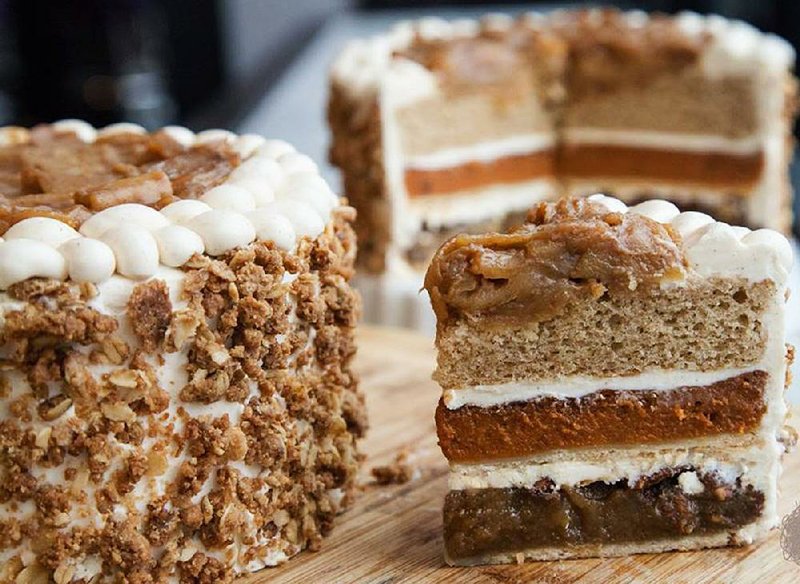The language of food is changing at breakneck speed to reflect new menus, new mashups, new diets, new hashtags.
"We need new words and labels to give voice to our food obsessions and anxieties," says Josh Friedland, the author of the new book Eatymology: The Dictionary of Modern Gastronomy. "And we especially need more words to describe gastronomic emoting," like "hangry."
Friedland says he suffers from "Nordepression," a state of acute ennui brought on by the words "new Nordic cuisine."
Dictionaries don't always keep up, but the online Oxford English Dictionary adopted plenty of food slang this year, such as "cakehole" and "cheffy." And this year's long-awaited revision of the Scrabble Tournament and Club Word List added useful food words like paczki (23 points), mojito (15 points) and yuzu (16 points).
Here are the 10 most interesting food words that arrived, and stayed, on our radar this year:
1. Cat Cafe (n.) A concept imported from Asia (where many new residential buildings do not allow pets). This is a high-end coffee bar where patrons can also enjoy the attention of free-roaming cats. A cat cafe, Meow Parlour, opened in New York in December 2014. The term was added to the Oxford English Dictionary this year.
2. Climatarian (adj.) Referring to a diet whose primary goal is to reverse climate change. This includes eating locally produced food (to reduce energy spent in transportation), choosing pork and poultry instead of beef and lamb (to limit gas emissions), and using every part of ingredients (apple cores, cheese rinds, etc.) to limit food waste.
3. Cookie Butter (n.) A sweet spread of pulverized cookies mixed with butter, sweetened condensed milk and peanut butter, or another soft ingredient. Cookie butter was first made in Belgium and the Netherlands with the locally popular spice cookies, speculoos. (A popular childhood snack over there is white bread spread with butter and sprinkled with crushed cookies, or chocolate sprinkles.) In the United States, recipes have proliferated for butters made from Oreos, graham crackers and Thin Mints.
4. Cuisinomane (n.) The new official Canadian French word for "foodie," as determined by the Office quebecois de la langue française. This agency is tasked with maintaining French as a living language in Quebec, and is particularly reluctant to adopt words from English. "Cuisinomane" follows the same form as "balletomane" and "bibliomane," meaning a person who is an obsessive fan of a certain art form.
5. Foodspo (n.) Formerly known as food porn, foodspo is used mostly on Instagram to tag a particularly beautiful or inspirational picture of food (a homemade pie or cake, very often). Foodspo was back-formed from "inspo," Internet shorthand for "inspiration."
6. Hangry (adj.) The state of being so hungry that you become angry or irritable. (The state is not new, of course, but used to be described as "having low blood sugar.") Added to the online Oxford English Dictionary in 2015.
7. Mayo (n.) Surely 2015 will go down in linguistic (and condiment) history as the year an eminent lawyer engaged in a protracted battle with the federal government over whether "mayo" is the same thing as "mayonnaise." The story began when Unilever (makers of Hellmann's mayonnaise) and the American Egg Board (a lobbying group) tried to force the vegan food company Hampton Creek to change the name of its popular eggless product Just Mayo. Citing the Food and Drug Administration standard for mayonnaise that defines it as a mixture of vegetable oil, vinegar, egg yolk and lemon juice, the groups persuaded the FDA to order Hampton Creek to change the name. But the company's lawyers fought back, arguing that "mayo" is not "mayonnaise," and therefore their product need not conform to FDA standards. In the meantime, emails were leaked, dirty tricks were revealed, and in October the chief executive of the American Egg Board was forced to step down. At press time, the is-mayo-mayonnaise issue had not been resolved.
8. Piecaken (n.) A multilayered dessert in which three 9-inch pies are baked inside three 10-inch cakes, then stacked. The tradition of stuffing foods inside other foods inside other foods (a practice termed "engastration," according to Friedland) for festive meals is an ancient one. This particular confection has been around for a long time, with multiple online recipes, but was previously termed a "cherpumple." (Referring to its contents: cherry pie, pumpkin pie and apple pie.) For obvious reasons, once the word "piecaken" (with its echoes of "turducken") was introduced this year by the pastry chef Zac Young of the David Burke Group restaurants, it caught on immediately on Twitter. The dessert has now spread to Britain and Australia. Up next: the pielogen, a pecan pie, a cheesecake and a yule log welded together with chocolate buttercream.
9. Wine O'Clock, Beer O'Clock (n.) One's personal assessment of the right time of day to start drinking a particular beverage. Added to the online Oxford English Dictionary in 2015.
10. Zarf (n.) The cardboard collar placed around a paper coffee cup to protect your hands from the heat. This item has usually been called a "cup sleeve" in modern times, but "zarf" is an old Arabic word, recently revived, for an ornamental holder for a coffee cup with no handle. Added to the online American Heritage Dictionary in 2015.
Postscript: "Foodie," the controversial term adopted by the Oxford English Dictionary in 1980, had a good run. But it hit the end of the road this year: It appears on the 2015 list of "banished" words published annually by Lake Superior State University in Sault St. Marie, Mich.
Weekend on 12/24/2015

